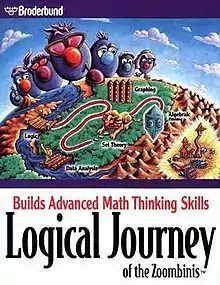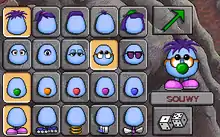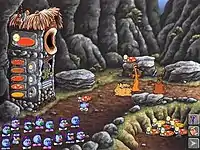Logical Journey of the Zoombinis
Logical Journey of the Zoombinis (also known as Zoombinis Logical Journey in the remake) is an educational puzzle video game developed and published by Broderbund for the original and The Learning Company for the remake. It is the first game in the Zoombinis video game series.
| Logical Journey of the Zoombinis | |
|---|---|
 | |
| Developer(s) | Broderbund (original) The Learning Company (remake) |
| Publisher(s) | Broderbund (original) The Learning Company (remake) |
| Series | Zoombinis |
| Platform(s) | Windows, Mac OS, OS X |
| Release | |
| Genre(s) | Educational, puzzle |
| Mode(s) | Single-player |
Gameplay

The Zoombinis are a race of small blue creatures depicted with varying facial features, initially living in prosperous peace on a small island called Zoombini Isle. However, they are tricked and enslaved by their neighbors, the Bloats. The game depicts the Zoombinis' search for a new home, featuring a variety of logical puzzles which the player must solve to get the Zoombinis to their new home. Most of the puzzles involve the physical features of the Zoombinis as part of the solution. For example, in the puzzle 'Allergic Cliffs', the player is given a choice of 2 bridges, each of which will allow Zoombinis to pass only if they have certain combinations of features. In total, there are 625 unique combinations, of which the game allows to make up to two Zoombinis (twins) with each combination, making 1,250 possible Zoombinis in total. Of these, 625 must be saved in order to win the game.
The Zoombinis travel in groups of a maximum of 16 per group across a series of puzzles. There are 12 puzzles in total, split into four sections of 3 puzzles each, and the Zoombinis must complete a path of 9 puzzles to establish their new home at 'Zoombiniton' ('Zoombiniville' in US version). The first and last 'legs' are compulsory and must be completed by all Zoombinis; for the second leg, the player is given a choice to take either the north or the south path. Between each 'leg' is a campsite where the Zoombinis can be stored for later retrieval.
The first time the player successfully brings an entire party of 16 Zoombinis through a leg, a building will be constructed at Zoombiniton/Zoombiniville to celebrate this achievement. If three parties of 16 are brought through a leg, the difficulty of that leg increases for future trips (unless it is already the maximum difficulty, named "Very, Very Hard" and color-coded red). The four difficulty levels are 'Not So Easy', 'Oh So Hard', 'Very Hard', and 'Very Very Hard', and each difficulty level is color-coded (green, purple, yellow, and red, respectively). Once a leg has increased in difficulty, there is no way to reverse the change.
Development
The game was created in 1995, and released in 1996.[1] The original version of the game by Broderbund Europe in March 1996 came in three languages: English, French, and German. The US division of Broderbund made some minor changes and released a US version in December 1996. As part of the US release they changed the names of several areas of the game. The US version of the game was expanded and republished as "Zoombinis Logical Journey v2.0" by The Learning Company in September 2001.
Remake
In February 2015, TERC, the original creator of Zoombinis launched a Kickstarter Campaign to release an updated version of the game for modern tablets and computers. On 25 March 2015, the crowdfunding campaign was funded successfully, with the total pledged double the original target of $50,000.[2] This updated version was scheduled to be released in Summer 2015.

.jpg.webp)
In 2015, Logical Journey was remade for modern systems, under the name Zoombinis.[3][4] The main improvements of the remake are updated graphics and that the game is designed to run on modern operating systems (iOS, Android, Windows, Mac, and others). Zoombinis was officially released on 6 August 2015 for iOS and Android and was released for Windows and Mac, as well as Kindle Fire,[5] on 28 October 2015.[6]
In 2014, TERC, the original creator of Zoombinis, began an internally funded redevelopment of the game. In March 2015, they launched a Kickstarter campaign to fund additional enhancements and releases, including PC and Kindle versions. It was successfully funded.[7] Also in 2015, the National Science Foundation awarded TERC nearly $2 million to study how much "computational thinking" kids do while playing Zoombinis, both at home and in the classroom, and whether teachers can extend the lessons outside the game.[8][9]
Reception
The Washington Post's Rob Pegoraro wrote that the game's pattern and deductive logic puzzles teach "how to think" rather than a specific skill.[10] Karney said the game was fun and praised its audio cues for children with little reading skills. In 1997, the game won "Best Home Education for Pre-Teens" at the 12th Codie awards.[11] The editors of PC Gamer US named Zoombinis 1996's "Best Educational Game", and wrote that it "has the same appeal and value for your brain as a favorite sport does for your body."[12] It was also a finalist for the Computer Game Developers Conference's 1996 "Best Educational Game" Spotlight Award,[13] but lost the prize to Freddi Fish 2.[14] It received 4 out of 5 stars from Macworld,[15] and 4 out of 5 from MacUser, whose editors declared it one of 1996's top 50 CD-ROMs.[16]
References
- "Logical Journey of the Zoombinis.(Broderbund)(The Learning Arcade) (Software Review)(Brief Article)(Evaluation)". Computer Shopper (subscription required). Archived from the original on 2014-06-29 – via HighBeam Research.
- "Zoombinis". TERC. Kickstarter. February 17, 2015. Retrieved February 17, 2015.
- "Zoombinis on the App Store". iTunes App Store. Retrieved 2016-04-16.
- "Zoombinis on Google Play". Google Play. Retrieved 2016-04-16.
- "Zoombinis app page". Amazon app store. Retrieved 11 November 2015.
- "Zoombinis Steam Page". Steam. Retrieved 11 November 2015.
- "Zoombinis". TERC. Kickstarter. February 17, 2015. Retrieved February 17, 2015.
- Toppo, Greg (2015-08-06). "How a beloved video game came back from the dead 20 years after its improbable birth". Usatoday.com. Retrieved 2016-04-16.
- "NSF Award Search: Award#1502882 - Zoombinis: The Full Development Implementation Research Study of a Computational Thinking Game for Upper Elementary and Middle School Learners". Nsf.gov. Retrieved 2016-04-16.
- Pegoraro, Rob (April 7, 1996). "The Learning Game". The Washington Post – via HighBeam Research (subscription required) . Archived from the original on June 29, 2014. Retrieved 23 May 2014.
- "1997 Codies awarded for best software". Tape-Disc Business – via HighBeam Research (subscription required) . April 1, 1997. Archived from the original on June 29, 2014. Retrieved 23 May 2014.
- "PC Gamer Reveals Its 1997 Award Winners". Business Wire (Press release). Brisbane, California. February 6, 1997.
- Staff (April 15, 1997). "And the Nominees Are..." Next Generation. Archived from the original on June 5, 1997. Retrieved March 17, 2020.
- "Spotlight Awards Winners Announced for Best Computer Games of 1996" (Press release). Santa Clara, California: Game Developers Conference. April 28, 1997. Archived from the original on July 3, 2011.
- Beekman, Ben; Beekman, George (July 1996). "Logical Journey of the Zoombinis". Macworld. Archived from the original on February 6, 1997.
- The Editors of MacUser (December 1996). "MacUser's 1996 Top 50 CD-ROMs". Kid's Stuff. Archived from the original on June 5, 2000. Retrieved March 17, 2020.